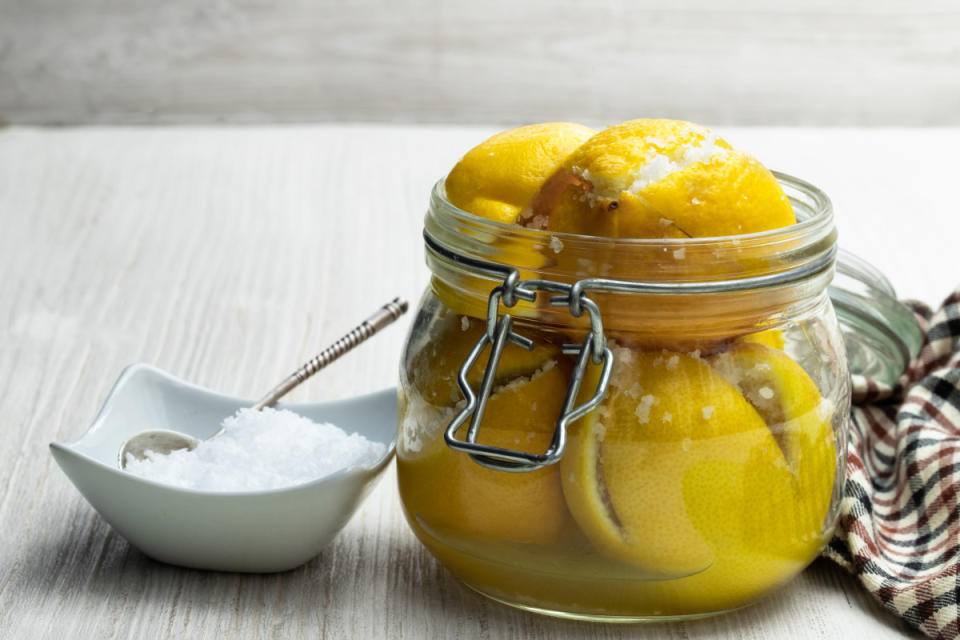The Secret Ingredient for the Best-Ever Lemon Bars

Lemon Bars
Come spring, it's time to put a little pep in your step. So this season, I want to help you in the baking department with a fresh new way to make brighter and zingier lemon bars. And you'll be pleased to know all it takes is one ingredient to give the classic citrus dessert bar new life: preserved lemon.
Related: 32 Best Lemon Dessert Recipes
What is Preserved Lemon?
Preserved lemon is a condiment made from lemons that have been cured in salt, sometimes with the addition of spices or extra flavorings. The process of making preserved lemons calls for slicing the lemons into quarters or halves, packing them in jars with salt, and letting them ferment for many weeks to months. At the end of that time you have a less bitter lemon with a soft peel. It's still tangy, but preserved lemons are also salty and have a deeper, richer, more complex flavor than fresh lemons. They're often added to savory dishes, but they're also a great addition to sweets.

Getty Images
You can buy whole preserved lemons or lemon paste in the condiment or the canned/jarred vegetable aisles of grocery stores. Preserving your own is also fairly simple—this helpful guide will show you how it's done. While the whole lemon—the peel, pulp, and juice—can be used, the peel of preserved lemons has the most concentrated flavor and its very tender texture makes it easy to blend the ingredient into your favorite dishes.
Related: Lemon Sour Cream Pound Cake
Why Should You Use Preserved Lemon in Lemon Bars?
In most traditional lemon bar or lemon square recipes, salt fights with sugar to be heard and unfortunately, loses to its sweet counterpart. When you incorporate preserved lemons into lemon bars, the cured complexity of the ingredient amplifies the salt and all of the other flavors. Lemon bars can sometimes be a little bit too sweet or one-note, but when you add preserved lemon you get a sharp, well-rounded treat. They're sweet but not too sweet and lemony but not just lemony.
Related: 17 Easy, Irresistible Sweet and Salty Treats
How Much Preserved Lemon Should You Add to Lemon Bars?
First, dial back on the amount of lemon juice by about a half. If a recipe calls for 3 to 4 lemons, juice two lemons instead. Next, add a 1/4 cup of preserved lemon—either preserved lemon paste or a finely diced whole preserved lemon—to the lemon bar filling. And skip any salt in the recipe. The preserved lemon is plenty salty as it is! This simple zesty lemon bar recipe is a great place to try this swap.
One word of warning: After you make lemon bars with preserved lemons, you might be ruined for all other lemon bars. If you want a wow-worthy baked good for a dinner party or spring gathering (or maybe your Easter dessert table), this lemon bar upgrade is calling your name.
Related: I Tried Reba McEntire's Porch Day Lemonade
How Else to Use Preserved Lemon
Once you have this bright condiment in your possession, you can use it for lemon bars or practically any savory or sweet dish that's in need of some brightness.
“It’s almost like somebody turned up the treble on your stereo,” says Phil Rosenthal of preserved lemons in his recipe for Moroccan Chicken With Preserved Lemons and Olives.“You’re getting notes that you never heard before, those high-end notes of complexity. It’s not just sour. There’s almost a vinegary tang to it, and it makes the whole dish come alive in your mouth.”
Here are some more ideas to help you put preserved lemons to delicious use.
Liven up salad dressings
Add more zing to rich and hearty soups
Perk up quick breads and pancakes
Invigorate creamy pasta sauces
Up next: The Secret Ingredient for the Best Garlic Bread You’ll Ever Have

